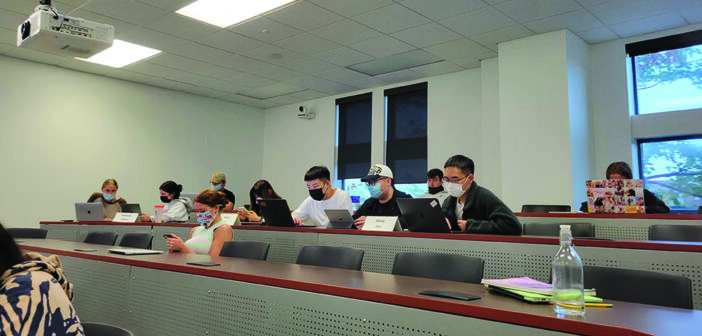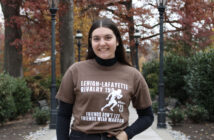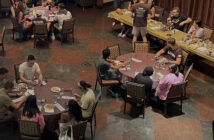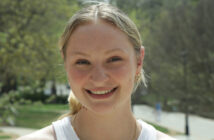The start of the academic year was two business days away and Professor María Bárbara Zepeda Cortés was assigned a classroom with 42 chairs for 52 students.
In her frustration she took to Twitter sharing that “the classroom assignment has been a nightmare!” and raised concerns about social distancing.
2 business days away from start of classes at Lehigh and the classroom assignment has been a nightmare! In one class I will share a room with 52 students and I have been given a room with 42 chairs. In another, of 25, I have been assigned this room ??And social distance, apá? ? pic.twitter.com/rUipXCDLt8
— Bárbara Zepeda (@MBZepedaCortes) August 19, 2021
The university does not have a policy requiring social distancing in classrooms this semester, said Steven Wilson, university registrar.
“This is certainly a concern that certain faculty are not happy with that decision,” Wilson said. “But that’s not actually what we (in Registration and Academic Services) have to worry about. We have certain rooms, these are the rooms that we’re teaching in, they’re (students and faculty) not going to be social distancing. Some faculty disagree with that.”
While mask wearing and vaccinations are required for students and faculty to be present in the classroom, some professors are still concerned about the lack of social distancing.
Zepeda Cortés, a professor in the department of history, is teaching two courses this semester: one on colonial Latin American history and another titled Narcos: The Global Drug Wars.
She said this year with COVID-19, she wanted a classroom where some social distancing was possible.
Last fall before the university moved to completely remote learning, Zepeda Cortés said she was going to be assigned an auditorium that could seat 100 people for 36 registered students.
“This year I was surprised that social distance ideas are gone,” Zepeda Cortés said.
During the week before classes started, Zepeda Cortés worked with those in charge of classroom assignments to find a room where all of her students would fit.
She was able to move her students into larger classrooms where every student did have a seat.
In her colonial Latin American history course she has 25 students with 50 chairs. In Narcos: The Global Drug Wars, she has 51 students and two teaching assistants with 65 chairs.
She said in one of the classrooms, she is teaching less than two feet from the front row.
“I thought ‘Oh my God we’re so close together, something’s going to happen.’ So I worry about that class,” she said.
Wilson said Registration and Academic Services uses a system that optimizes classroom assignments based on the expected enrollment, the time of day and the technology and other amenities requested.
Wilson said if a faculty member had contacted the registrar early enough, they may have been able to accommodate changes to give them more room.
He said issues can arise when departments or faculty let students register for a course when it is full or if they override the capacity given to the registrar.
He said in these situations it can become difficult to find faculty a larger classroom.
“We have only so many rooms and so many blocks of time during the day,” Wilson said “We did the best that we could.”
Professor Virginia McSwain is teaching Introduction to Astronomy this semester in a room for 80, filled nearly to capacity.
She said there is very little space between the rows and almost no arm rest separation between students.
“It’s very tightly packed and it makes me nervous to teach in such a tightly packed classroom. I think it makes the students nervous,” she said.
McSwain put a policy in her syllabus that students do not need to attend her class in person. She records her lectures on Panopto as a remote option for students.
“I normally require attendance and participation, but I cannot in good conscience require people to attend class with that kind of situation. I think it is dangerous,” she said.
Provost Nathan Urban sent an email to faculty and staff on Sept. 3 discussing positive COVID-19 cases among students and shared new classroom protocols.
The email said there is no evidence of transmission occurring in classrooms with masking in place and the university will continue to monitor this.
The Brown and White spoke with Lori Friedman, Lehigh’s director of media relations, to learn more about the evidence that supports the claim that COVID-19 transmission is not occurring in masked classrooms.
She said part of the contact tracing process includes gathering information about where and when transmission may have occurred.
“While it can be challenging to determine whether the most likely source of student to student transmission in the classroom—because it is not the only place that students gather—the classroom is the primary place where faculty and students interact, and we have not seen that type of transmission from student to faculty (or vice versa) in a fully-masked classroom,” she said.
McSwain said that while last year there were no documented cases of COVID-19 spread in classrooms, it is important to note that classrooms do look different this year with less social distancing and higher capacities.
As of Sept. 7, the university will begin notifying instructors when a student in their class tests positive for COVID-19, the email said.
Instructors will be notified via a personalized dashboard through a system called Argos.
The email said once the instructor is aware of the number of positive COVID-19 cases in their classroom, they must notify all students in the class of the case count.
There is currently no university-wide policy on how isolated or quarantined students attend class. Rather, that decision is left to the individual professor.
After Sept. 13, professors may conduct their classes remotely if over 30 percent of the students are in quarantine or isolation, the email said.






Comment policy
Comments posted to The Brown and White website are reviewed by a moderator before being approved. Incendiary speech or harassing language, including comments targeted at individuals, may be deemed unacceptable and not published. Spam and other soliciting will also be declined.
The Brown and White also reserves the right to not publish entirely anonymous comments.
1 Comment
Stick all the students who went to the Fetty Wap concert together and social distancing the others